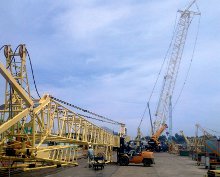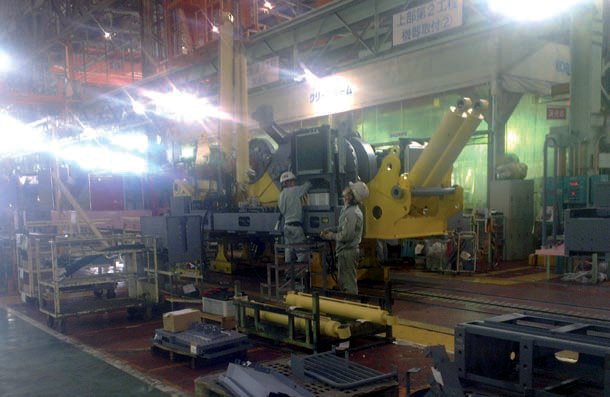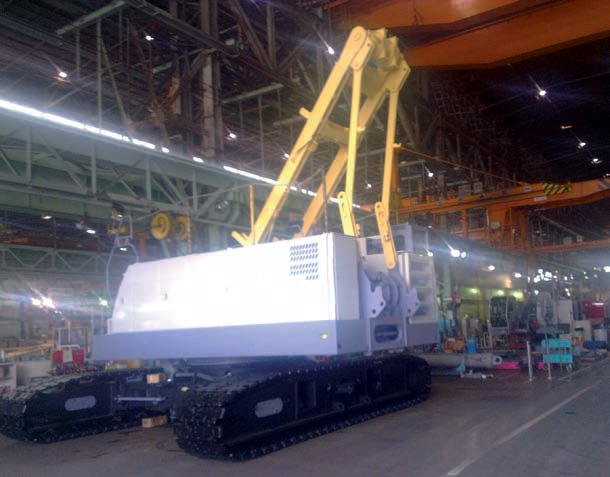Cutting costs, keeping quality
17 September 2014The next stop on Cranes Today’s Japan Tour was at Kobelco’s plant in Akashi, close to Kobe, home of parent company Kobe Steel. Earlier in the week, at the company’s Tokyo head office, CEO Akihiko Tsukamoto has been working to cut procurement costs and improve production efficiency.
Tsukamoto came to Kobelco Cranes two years ago, from parent company Kobe Steel. Joining the company as it, and the crane industry worldwide, struggled with the effects of the global financial crisis, he saw that a long term plan for reducing costs was essential. This plan was known by the company as the Cross Project.
Tsukamoto says, "Kobelco Cranes was established in 2004. We've increased our turnover every year since then. But, after the Lehman shock, the crane business started going down. We lost money from 2010-2012, over three years. In 2013, we made a mid-term plan. First, we must survive in this business. We must consider how to make a profit in short term. And, we must plan for our future business vision.
"In the first year after this plan, 2013, we saw that demand would not be increasing too drastically. We decided to make our factories more efficient. We developed some new kinds of Kaizen [continuous improvement], and also tried to reduce the costs of goods across the product.
"On the cost reduction side, we focused on procurement, we tried to procure from outside of Japan. We achieved our target of 20% cost reduction."
But, Takemichi Hirakawa, general manager, corporate planning and administration department, says, merely looking overseas wasn't the only way to reduce procurement costs: " In 2012, the Japanese yen was still strong, so by importing we were able to reduce costs; now, the Yen, is getting weaker. So, we can't expand our overseas procurement too much. At the same time though, Japanese suppliers have also been working to reduce the costs of their products."
Tsukamoto's next step was to look not at the materials Kobelco was using, but at the machines it was building. He says, "For our future plans, we considered our business domain. We have crawler cranes, and we have rough terrain cranes in Japan. We decided to concentrate on the crawler business in future. We have now been making detailed plans over the last year.
"In 2013, due to a very big increase in demand for crawlers in Japan, South East Asia and the US, helped by the weak Japanese Yen, we achieved our target of profitability, of US$32m.
"The share of our business in overseas markets is about 70% now. The weak Japanese yen has made a good difference for us.
"We again achieved our target for cost reduction in 2013. Our profit was increased, by about $50m from last year. About 30% of this result came from own efforts in cost reduction, and about 70% came from the economic environment.
"Our target in the next five or six years is to make our company strong for these kinds of fluctuation in the economic environment.
"We have also developed our strategy for the long term. We first considered small and mid-size crawlers. In the future our competitors from China and India will be stronger. They will get some portion of the market share, so we must try to keep reducing the costs of these cranes, to keep them competitive. Secondly, the main market for crawlers will be for larger size cranes.
We have some products over 300t, but we have not been successful globally in this market. So, we must try to enhance our large size crane business in future.
"In our development strategy we will concentrate on large sized crawler cranes. Now, we have started to make some product concepts, based on the market needs, and we have organised a team for this.
"So, with this kind of effort, this year our profit will be more than last year . Officially, our target is $35m, but we are hoping for more. In 2015, we aim to again increase our profit from this year. And our target after ten years, in 2023-24, is a turnover of $1bn, with $100m profit."
Lean and well-tailored
While the company is shaping its product line to where it sees the most success with customers, it is also shaping its production to keep costs down, while at the same time building every machine from scratch to each customers' exact requirements.
Tsukamoto says, "For the small and mid size cranes, we are in the middle of a big project, revising the process from order to shipment. We aim to make it one very smooth stream, reducing all of the waste.
We want to make lead times shorter, and reduce waste. The production process has many steps: but some parts go well, while others make delays. That brings waste and waiting time. The main factor of this project is to make the entire product from order."
This new system is known as Magma. Vice-president Tasuku Aoyama, explains, "In Japan, we have limited land, with high labour, resource and energy costs. So, Japanese companies always pursue production efficiency. Too much efficiency though means everything is managed from the viewpoint of production, which means we sometimes miss the most important thing, the needs and wishes of the customers. So, it makes sense to follow the best efficiency, but we need to introduce these kinds of things into production. The production system has to set the highest priority on the customer needs.
"This is, in wording, very easy, but for production people, it is a different philosophy - a new concept.
To introduce this, we need to explain and convince customers, sub suppliers, engineers, production people, sales and distribution.
"We started preparation in October of last year, and introduced the project from April. In our previous production system, sales people predicted sales and then we produced the number of machines accordng to that forecast with standard specifications. We'd then complete assembly and once we have final specifications, we finish the machine and ship to the customer.
"Just before shipment, preparation is heavily loaded: some customers have very tough requirements. This sometimes takes time, sometimes there are problems. It makes it very hard to offer a fixed delivery date, or to fully comply with customer requirements. We may ask them to change or customise their needs.
"This is due to the standardised production system. It meant we had to ask customers to compromise on requirements or delivery date. It does not place the highest requirement on customer needs.
"Now, we finalise the customer requirement of the machine first, then plan production, and offer a guaranteed delivery date. So, our new system follows customer requirements from the start of production."
As well as making sure each crane is built from the star t with the end user in mind, the reorganisation will make sure that at every stage the production team or supplier is responsible for meeting customer demands.
Aoyama says, "In this system, at each stage like cutting, welding, or machining, the team has the right to reject the parts from the previous process. So every production process has full responsibility to comply with what they need to do. With suppliers, if one bolt is missing, the whole machine will be delayed and delivery msissed. We can idenitfy who supplies each part, and tell the supplier when it is their responsibility.
"In the old system, there was always a delay between assembly and finishing, so we couldn't identify the source of problems. With this new system, each team or suppliers' role is directly identified to the customer demands."
The astonishing technology and automation of Kobelco's plant makes this tightly controlled process possible. Cranes Today walked around the plant with Toshiharu Yamashita, who is responsible for implementing Magma at the production level.
This plant (one of three) covers 120,000sq m, with seven lines, and employs 800 staff, including contractors. Whie the staff work only during the day, five robotic drilling machines continue fabrication overnight. Each machine can rotate parts for drilling 360° over five dimensions. While the staff sleep, they prepare parts for the next day's production.
Each of the six main production steps for small cranes takes around three-to-four hours. Alongside, sub component lines flow in parts as they are needed.
Kobelco sees part of the strength in its production processes as coming from its close links to its parent company.
Aoyama says, "From a management basis, we are an independent entity. From a technology point of view, we have a very good welding robot team; we ask them for the best way to weld cranes. Sometimes, if there are problems in the machines, we can ask our R&D centre at Kobe Steel to perform tests."
Yamashita says, "When we talk about our technology, we're not only a crane company, we're part of the whole Kobe network. So we align with all of their R&D systems, their robots, etc. That's our strength compared to our competitors."


